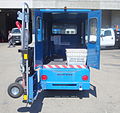2011 Ford E250 Cargo Owner Guide 3rd Printing - Page 163
2011 Ford E250 Cargo Manual
Page 163 highlights
Tires, Wheels and Loading 7. Remove the valve cap from the valve stem on the right front tire; decrease the air pressure until the horn sounds. 8. Remove the valve cap from the valve stem on the right rear tire; decrease the air pressure until the horn sounds. 9. Remove the valve cap from the valve stem on the left rear tire; decrease the air pressure until the horn sounds. Training is complete after the horn sounds for the last tire trained (driver's side rear tire), the TPMS indicator stops flashing, and the message center (if equipped) displays: TRAINING COMPLETE. 10. Turn the ignition off. If two short horn beeps are heard, the reset procedure was unsuccessful and must be repeated. If after repeating the procedure and two short beeps are heard when the ignition is turned to off, seek assistance from your authorized dealer. 11. Set all four tires to the recommended air pressure as indicated on the Safety Compliance Certification Label or Tire Label located on the B-Pillar or the edge of the driver's door. See Vehicle loading - with and without a trailer in this chapter for more information. SNOW TIRES AND CHAINS WARNING: Snow tires must be the same size, load index, speed rating as those originally provided by Ford. Use of any tire or wheel not recommended by Ford can affect the safety and performance of your vehicle, which could result in an increased risk of loss of vehicle control, vehicle rollover, personal injury and death. Additionally, the use of non-recommended tires and wheels could cause steering, suspension, axle or transfer case/power transfer unit failure. The tires on your vehicle have all-weather treads to provide traction in rain and snow. However, in some climates, you may need to use snow tires and chains. If you need to use chains, it is recommended that steel wheels (of the same size and specifications) be used, as chains may chip aluminum wheels. Note: The suspension insulation and bumpers will help prevent vehicle damage. Do not remove these components from your vehicle when using snow tires and chains. 163 2011 Econoline (eco) Owners Guide, 3rd Printing USA (fus)
















